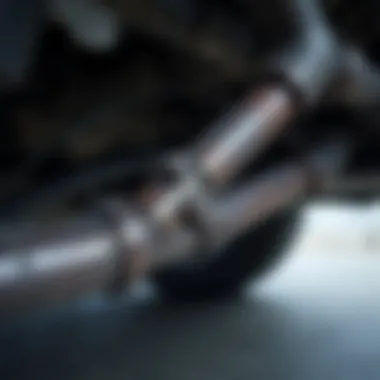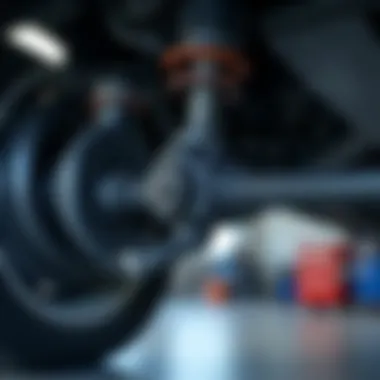Understanding Ford Flex Sway Bar Links: A Detailed Guide


Intro
When it comes to vehicle performance, sway bar links often don't get the spotlight they deserve, especially in a versatile model like the Ford Flex. These components play a crucial role in stabilizing the vehicle, affecting how it handles corners and interacts with the road. Understanding sway bar links in the Ford Flex isn’t just for mechanics or engineers; it's essential for any car enthusiast who wants to grasp the intricacies of their vehicle's dynamics.
As the Ford Flex navigates through various terrains, the sway bar links serve as a bridge, connecting the sway bar to the suspension components. When these links are functioning optimally, they help maintain balance and control, providing a smoother driving experience. However, when they wear out, drivers may start to notice a decline in performance, leading to bumpy rides and compromised safety. This article delves into the various aspects surrounding sway bar links, from basic functionalities to intricate replacement processes, ensuring you have the knowledge to maintain this critical part of your Ford Flex.
Vehicle Insights
Model Comparisons
The Ford Flex has a unique standing in the SUV market, blending features from minivans and traditional SUVs. When compared to its contemporaries like the Honda Pilot or the Chevrolet Traverse, the Flex offers a distinct driving experience. The sway bar link assembly is somewhat similar across these models, but the Ford Flex excels in terms of ride comfort and handling due to its sophisticated suspension setup. This can be attributed to the precise calibration of its sway bar links, which are designed to enhance stability without sacrificing agility.
Performance Reviews
Performance is where the rubber meets the road, and sway bar links significantly impact handling. With a high viewpoint into the Flex’s performance, it’s clear that even minor wear in the sway bar links can lead to wobbly rides and steering issues. Reviews from users often highlight a noticeable difference in handling when new sway bar links are installed compared to worn-out ones. Users praise the enhancement in cornering stability and overall vehicle responsiveness.
"A smooth cruise isn’t just about engine power; it’s about how well all the components work together, and the sway bar links play a crucial role in that."
– Automotive Expert Review
Understanding Sway Bar Links
Understanding sway bar links is fundamental for anyone wanting to grasp suspension mechanics, especially with a focus on the Ford Flex. Sway bar links are not just mere components; they play a crucial part in ensuring vehicle stability, handling, and safety. In this section, we’ll break down what these links do, why they matter, and how they integrate into the broader suspension system.
What are Sway Bar Links?
Sway bar links, often overlooked by the average vehicle owner, are vital parts of your car's suspension system. They connect the sway (or anti-roll) bar to the suspension components, effectively helping to manage the weight transfer as the vehicle navigates turns. When shifts occur, these links help maintain stability by countering the lateral forces that would otherwise tip or roll the vehicle.
Understanding their function can illuminate why they’re so important. Simply put, without functioning sway bar links, the car can feel unsteady during cornering. Think of them like the unsung heroes of automotive handling – small but mighty.
Role of Sway Bar Links in Suspension System
Now, let’s dive deeper into the role sway bar links play within the overall suspension system. These links are integral to minimizing body roll during sharp turns. When you steer into a curve, the vehicle’s weight shifts toward the outside of the turn. This is where the sway bar and its links come in. They transfer some of that weight back to the inside wheels, allowing the car to grip the road better.
To make it clearer:
- Reduction of body roll: Sway bar links make sure your car doesn’t lean too much in turns, leading to a smoother ride.
- Enhanced handling: With those links working properly, you get better responsiveness to steering, which is nice to have when you’re maneuvering in tight spaces or driving with some gusto.
- Improved safety: By keeping the car more stable, sway bar links can indeed play a role in preventing accidents during unexpected maneuvering.
Components of a Sway Bar Link
A typical sway bar link consists of several parts that contribute to its functionality. Understanding these components can provide insights into potential issues down the line.
- Ball Joints: These connect the sway bar to the links and allow for necessary movement. They’re quite important for articulation and flexibility, especially with uneven terrains.
- Bushings: Usually made of rubber or polyurethane, these cushion the sway bar link’s motion, absorbing vibrations and reducing noise.
- Connectors: These are used to attach the links to the sway bar and suspension. Depending on the vehicle, the design might vary, but their purpose remains the same.
By breaking down the components, you get a clearer picture of how interconnected the system is, which makes troubleshooting issues with sway bar links easier down the road.
Sway Bar Links in the Ford Flex


Understanding the specific characteristics of sway bar links in the Ford Flex is quite vital for both automotive enthusiasts and professionals alike. These components play a crucial role in maintaining stability and enhancing handling performance, especially when navigating through curves or uneven terrains. Given that the Ford Flex is a vehicle designed with a focus on family and comfort, having effective sway bar links is integral to ensuring a smooth ride.
Specific Design of Ford Flex Sway Bar Links
The sway bar links in the Ford Flex showcase a unique design tailored to its specific suspension system. Unlike other vehicles which might use generic sway bar links, those for the Flex are optimized for its independent suspension configuration. These links typically include durable materials engineered to withstand the stresses of day-to-day driving.
- Material Composition: The links often comprise high-strength steel with rubber bushings for flexibility. This combination helps absorb impacts and vibrations, enhancing ride quality.
- Link Geometry: The design ensures that the sway bar effectively counteracts the forces during cornering, promoting better vehicle stability.
When examining these sway bar links, it’s essential to note that Ford’s engineering team paid particular attention to load distribution and connection points. This precise engineering contributes to not just performance but also extends the lifespan of the components, which often is an oversight in aftermarket alternatives.
Comparison with Other Ford Models
While the sway bar links in the Ford Flex are quite distinct, comparing them to other models within the Ford lineup illuminates noteworthy differences and design philosophies.
- Ford Escape: The sway bar links on the Escape are smaller and designed for a compact SUV profile. These components emphasize agility over stability, reflecting the vehicle's purpose as a city-friendly crossover.
- Ford F-150: On the contrary, the F-150's links are considerably more robust, built to accommodate the heavy-duty demands of a truck. This vehicle’s configuration showcases links designed for maximum load-bearing capacity and off-road prowess.
By contrasting the Ford Flex sway bar links with those in other models, it becomes evident that designing these parts are no one-size-fits-all endeavor. Each vehicle’s intended purpose reflects through its sway bar design, impacting handling dynamics fundamentally.
"Sway bar links may seem unassuming but they give a backbone to your vehicle's suspension system. They're not just metal rods; they influence your driving experience profoundly."
In summary, the specialized design of sway bar links for the Ford Flex is indicative of their importance in ensuring effective performance and safety. Recognizing how these components differentiate from others in the Ford family can empower owners to appreciate their vehicle’s engineering more deeply.
Common Issues with Sway Bar Links
Sway bar links play a crucial role in maintaining the stability of a vehicle, particularly in a Ford Flex. Understanding the common issues associated with these components is essential not only for safety but also for the overall performance of the vehicle. Addressing problems with sway bar links can prevent further damage to the suspension system and enhance your driving experience. Here, we dig into the specifics of what to watch for, the underlying causes of wear, and the resultant impacts on vehicle dynamics.
Symptoms of Failing Sway Bar Links
When sway bar links start to fail, the effects are usually noticeable during driving. Here are some key symptoms to look out for:
- Clunking Noise: A common sign is a clunking sound coming from the suspension system when driving over bumps or uneven surfaces. This noise often indicates that the sway bar link is loose or damaged.
- Increased Body Roll: If the vehicle leans excessively during turns or feels unstable, it could be due to worn sway bar links, which compromise the suspension's ability to control body movement.
- Vibration: Some drivers may feel increased vibration through the steering wheel, which can be unsettling and indicates a potential issue with the sway bar links or related components.
- Uneven Tire Wear: If the links are not functioning correctly, it may lead to irregular tire wear patterns, particularly on the front tires. Monitoring tire health can provide further insight into the condition of the sway bar links.
Causes of Sway Bar Link Wear
Several factors contribute to the wear and tear of sway bar links, leading to the issues mentioned above:
- Road Conditions: Prolonged exposure to rough roads, potholes, and debris can cause significant strain on sway bar links, accelerating their deterioration.
- Material Fatigue: Over time, the materials used to construct sway bar links can weaken, especially if they are made of lower-quality materials that are not suited for long-term use.
- Weather Elements: Corrosive elements such as salt from winter roads and moisture can lead to rust, which weakens the structural integrity of metal components in sway bar links.
- Improper Installation: If the sway bar links were not installed correctly during a previous service, it may lead to premature failure. Ensuring proper alignment and torque specifications is critical.
Impact on Vehicle Performance
Failing sway bar links can significantly impact the overall handling and safety of a Ford Flex:
- Decreased Handling Precision: The vehicle may not respond as well to steering input, making it feel less stable during turns. This can compromise driver confidence and necessitate more cautious driving.
- Increased Risk of Rollovers: A compromised sway bar link can worsen body roll characteristics, heightening the risk of a rollover during sharp turns or sudden maneuvers.
- Impaired Ride Quality: Drivers might experience a rough or jarring ride, detracting from the comfort expected in a Ford Flex. Poor ride quality can be particularly noticeable on longer trips.
- Unpredictable Braking Performance: When body roll and vehicle stability are affected, braking performance may become inconsistent, which raises overall safety concerns.
Addressing these common issues promptly can save time and money in the long run, ensuring your Ford Flex remains a reliable vehicle.


Replacement of Sway Bar Links
Replacing sway bar links is crucial for maintaining not only the Ford Flex's suspension system but also the overall safety and performance of the vehicle. Neglecting to replace worn or damaged links could lead to a compromised suspension, causing uneven tire wear and poor handling. When sway bar links are functioning correctly, they help stabilize the vehicle during cornering, which is vital for driving safety. Having a clear understanding of when and how to replace these links empowers owners and mechanics alike to ensure that their Ford Flex operates optimally.
When to Replace Sway Bar Links
Recognizing the right moment to replace sway bar links can save drivers from more significant headaches down the road. Common indicators include hearing unusual noises such as clunking or rattling sounds when driving over bumps or making tight turns. Another sign might be the vehicle’s handling characteristics; if you notice more body roll in corners or a feeling of instability, it’s time to inspect the sway bar links.
Regular visual inspections can also be beneficial. Check for any visible wear or damage such as rust, cracks, or broken parts. Generally, if sway bar links have excessive play, it’s a clear sign they need replacing. It’s always better to err on the side of caution when it comes to vehicle safety.
Do-It-Yourself Replacement Guide
Necessary Tools
To embark on a DIY sway bar link replacement, having the right tools is non-negotiable. The primary tools required typically include:
- Socket set – Essential for loosening and tightening bolt connections.
- Torque wrench – To ensure that the sway bar links are fastened to the correct specifications.
- Pry bar – Helps to align components during installation.
- Jack and jack stands – Critical for lifting the vehicle for safe access.
These tools are widely regarded as essential for automotive work and are commonly found in most households equipped with basic mechanic tools. Ensuring that you have these tools on hand will make the replacement process smoother and more efficient.
Step-by-Step Process
The process of replacing sway bar links is methodical and straightforward, which is appealing for DIYers. Here’s a brief outline:
- Lift the vehicle using a jack and secure it with jack stands.
- Remove the wheel to gain better access to the sway bar links.
- Disconnect the old sway bar links from both the sway bar and the control arm.
- Install new sway bar links by threading them into place and tightening them to manufacturer specifications.
- Reattach the wheel and lower the vehicle.
Adhering to this step-by-step approach not only simplifies the task but also minimizes chances of errors during installation.
Post-Replacement Checks
Once the replacement is completed, conducting post-replacement checks is vital. This includes ensuring that all nuts and bolts are tightened, checking for any abnormal sounds while driving, and keeping an eye on the alignment. Afterward, a test drive on a smooth surface can reveal if everything was installed correctly; listen for unusual noises or handling issues. This methodical approach ensures the new links effectively contribute to the stability of the Ford Flex.
Professional Replacement Services
For those who may not feel comfortable performing the replacement themselves, seeking professional replacement services is also a practical choice. Professional mechanics have specialized knowledge and can often complete the job more efficiently, ensuring that the sway bar links are installed correctly. They also carry the necessary tools and can provide additional troubleshooting if other suspension components require attention. Moreover, a professional service often comes with a guarantee or warranty, providing peace of mind for vehicle owners.
Aftermarket Sway Bar Links
When it comes to improving the performance and safety of the Ford Flex, aftermarket sway bar links play a pivotal role. These components offer a myriad of options that can enhance handling and responsiveness while also providing alternatives for those looking to replace their factory parts. Given the demands of varied driving conditions and personal preferences, aftermarket sway bar links can be a beneficial addition for any Ford Flex owner.
Choosing Aftermarket Links
Benefits of Upgrading
Choosing aftermarket sway bar links can significantly upgrade your vehicle's performance. One of the core benefits is increased stability. Upgraded links can better endure the rigors of everyday driving, especially during abrupt maneuvering or cornering. They are engineered to provide enhanced strength and durability compared to standard links. This added resilience can reduce wear and tear, which translates to cost savings in the long run. Additionally, many aftermarket options come with superior materials that reduce flex and allow for more precise handling.


A standout feature of these upgrades is the adjustability they often feature. Adjustable sway bar links allow drivers the ability to fine-tune their vehicle’s suspension settings according to personal driving style or specific needs, whether it be for performance driving or everyday comfort. This flexibility is a compelling reason aftermarket options are popular among enthusiasts seeking both performance enhancements and aesthetic upgrades for their Ford Flex.
Potential Drawbacks
While the advantages of aftermarket sway bar links are enticing, they are not without their potential pitfalls. One significant aspect to consider is compatibility issues. Not all aftermarket parts align perfectly with the Ford Flex specifications, potentially leading to improper fits or clearance problems. If not installed correctly, this could lead to decreased performance or premature failure of the parts.
Another concern is the variability in quality among different aftermarket products. Some brands may prioritize flashiness over functionality or use subpar materials, leading to components that don't last as long as their factory counterparts. It’s crucial for buyers to perform due diligence on brands and read reviews to ensure the best investment in sway bar links to foster safety and performance in their Flex.
Top Brands for Ford Flex Sway Bar Links
When considering aftermarket sway bar links, certain brands have emerged as reputable options for Ford Flex owners. Some top contenders include:
- Energy Suspension: Known for their high-quality polyurethane components that enhance responsiveness and longevity.
- Moog: Offers robust designs that are built to withstand harsher driving conditions, ensuring safety and performance.
- AC Delco: Provides affordable replacement options that meet or exceed OEM specifications.
- Whiteline: Offers innovative designs that focus on performance and adaptability, catering to the enthusiast market.
Maintenance Practices for Sway Bar Links
Proper maintenance practices for sway bar links contribute significantly to the overall performance and safety of the Ford Flex. These components are vital in ensuring vehicle stability and comfort, particularly during turns and sudden maneuvers. Ignoring their maintenance can lead to premature wear and tear, which can escalate into notable safety hazards on the road. In this section, we will examine some crucial maintenance elements including routine inspections and optimal performance tactics, both of which are fundamental for sustaining the functional integrity of sway bar links.
Routine Inspections
Regular inspections of sway bar links can help detect any signs of wear before they become serious problems. This preventative measure not only prolongs the life of the sway bar links, but it also safeguards the entire suspension system of the Ford Flex. When conducting inspections, here are a few points to consider:
- Visual Examination: Look for any visible damage, such as cracks or rust on the sway bar links and their bushings. Damage often manifests itself through corrosion and physical deformation.
- Worn Bushings: Pay close attention to the bushings of the sway bar links. Worn or cracked bushings can significantly affect handling and cause more noise than usual. When bushings are worn out, they allow excessive movement of the sway bar link, which can lead to a decrease in stability.
- Movement Test: A simple test consists of checking the sway bar link's movement. If you can wiggle it more than a fraction of an inch, it may indicate weakness. This point is essential for knowing when to replace components to avoid further issues.
Scheduling these inspections routinely, ideally every few thousand miles or during regular service intervals, can be a game-changer in maintaining the health of the sway bar links.
Maintaining Optimal Performance
To stay ahead of performance issues related to sway bar links, integrating a few maintenance practices into your routine can be beneficial. Here’s how to keep everything running smoothly:
- Lubrication: Regularly lubricate the sway bar links. Proper lubrication reduces friction and wear on the components, allowing them to perform as intended. Using appropriate grease according to manufacturer specifications is essential.
- Tightening Bolts: Over time, bolts that connect sway bar links to the suspension can become loose. Including a periodic check of these bolts in your maintenance routine can help avert any unforeseen accidents or changes in handling.
- Alignment Checks: Vehicle alignment can have a substantial impact on the automotive dynamics of the Ford Flex. Poor alignment may exert undue stress on sway bar links, causing them to wear faster. Getting your vehicle aligned regularly helps maintain optimal performance of not just the sway bar links, but of the suspension system as a whole.
The Importance of Functioning Sway Bar Links
Sway bar links play a pivotal role in the overall suspension system of a vehicle. In the Ford Flex, these components ensure that the vehicle maintains stability during turns and sharp maneuvers. Properly functioning sway bar links contribute dramatically to the handling capabilities and ride quality. When these links are in good condition, they help to balance the forces that act on each side of the vehicle, allowing for a smoother, more controlled ride. This balance is no small feat, especially considering the various conditions under which a driver may operate their vehicle, from rough roads to tight corners.
Impact on Vehicle Handling
When sway bar links are operating as intended, one can certainly feel the difference. The car’s ability to corner without excessive lean is largely attributed to the sway bar’s interaction with its links. Imagine gliding around a curve with sufficient grip, where the vehicle feels stable and secure. That’s the work of intact sway bar links. Competition racers know this well, utilizing top-notch sway bar link setups to maximize their grip on the track.
In contrast, if these links become worn or damaged, the effects can be quite noticeable. A driver may experience excessive body roll or difficulty in steering, which, over time, can lead to an unsettling driving experience. It’s as if the vehicle has lost its sense of direction, making the journey anything but pleasant. Uneven weight distribution during maneuvers can also result in one side of the vehicle being favored over the other, causing unpredictable handling. Proper maintenance and understanding the signs of wear can keep one’s Ford Flex steady on the road.
Safety Considerations
Safety shouldn’t be taken lightly when discussing sway bar links. In terms of vehicle safety, functioning sway bar links are vital. The sway bar, along with its links, works hand-in-hand to minimize the likelihood of rollovers. A vehicle that leans too heavily in a turn is at a much greater risk of overturning. This is particularly important for larger vehicles like the Ford Flex, which has a higher center of gravity.
Another integral aspect is how sway bar links contribute to overall vehicle stability under various driving conditions. Whether you're navigating a winding mountain pass or simply cruising down the highway, functional sway bar links help maintain proper tire contact with the road surface. This consistent contact enhances braking performance, especially in emergency situations. If sway bar links are compromised, one might find their Ford Flex taking longer to stop or struggling to handle sudden changes in direction.
Maintaining fully operational sway bar links can ultimately save lives and prevent costly repairs.
In summary, sway bar links are more than just hardware; they are essential for handling, stability, and safety of the Ford Flex. Their importance cannot be overstated, especially for those who seek to ensure a secure and reliable driving experience.















